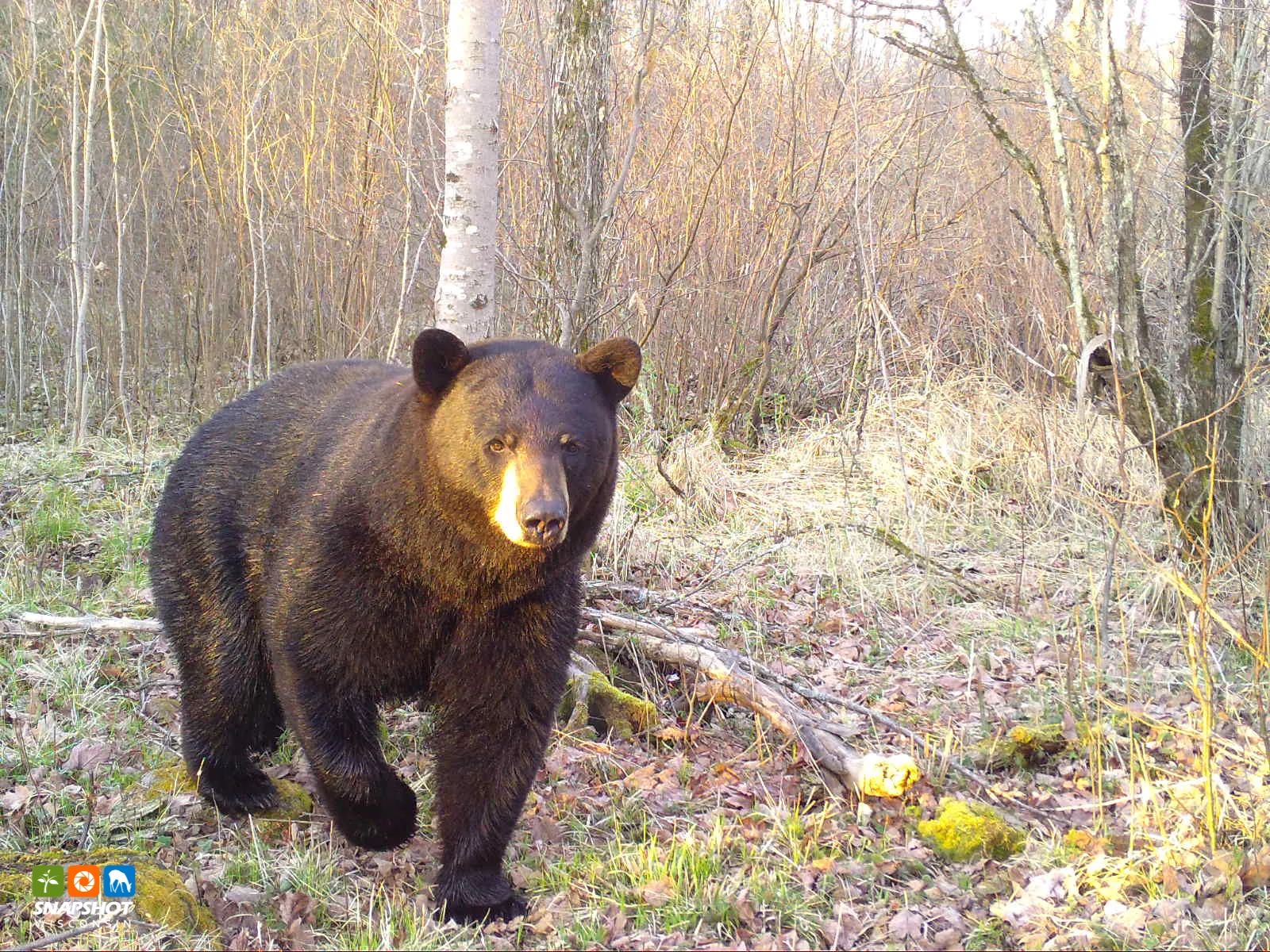Black Bears in Wisconsin

Black bears (Ursus americanus) are the most abundant and widely distributed bear species in North America, and the only bear species found in Wisconsin. Most Wisconsin black bears are all black, with a brown muzzle and may have patches of white on their chest. Although rare in Wisconsin, black bears can exhibit a variety of fur color patterns, including blonde, brown, cinnamon, blue-gray and even white.
Black bears have distinct cultural, ecological and economic values. Seeing a black bear in the wild is an exciting experience for many and an equal thrill for those who prize the black bear as a big game species. Bears also play important roles in their local ecosystems due to foraging activities and have profound cultural significance to Native Americans.
Biology & Life Cycle
Below are some fast facts about black bear biology and life cycle. If you are looking for more on all things black bear, visit the About Black Bears section from BearWise®.
Bear Biology 101
- Black Bears are one of three bear species native to North America and are the only species of bear found in Wisconsin.
- Adult males (called boars) typically weigh from 125-550 lbs., while females (sows) can weigh from 90-375 lbs. Some exceptional black bears can grow to over 800 lbs.!
- Black bears possess an amazingly powerful sense of smell that helps them track down food sources, even from a mile away!
- When searching for insect colonies, bears often break down decomposing logs on the forest floor, contributing to nutrient cycling in the soil. Bears often eat fruits and plants whole, which contributes to the seed dispersal of plant species within their home ranges.
Bear Life Cycle 101
- Black bears are omnivores, with most of their annual diet consisting of various plants, berries and nuts. Black bears' diet follows the seasons. These seasonal foods include forbs and grasses in the spring, berries and insect colonies in the summer, and apples and acorns in the fall. Black bears will also opportunistically scavenge on animal carcasses, white-tailed deer fawns, and may take advantage of human-made food sources such as corn fields, bird feeders and trash.
- Bears are generally solitary animals, except for sows with cubs and during the mating season. Bear mating season starts in early summer, and sows give birth to litters of one to five cubs during hibernation, usually in January. Cubs stay with the sow until they are about 18 months old, when the family unit breaks up so the sow can breed again.
- Black bear home ranges cover large areas to ensure they can find all the resources they need throughout the year. Sows with young cubs tend to have the smallest home ranges (~6sqmi), whereas adult males tend to have the largest home ranges (~35sqmi) and overlap several females.
- Black bears go into a prolonged state of reduced activity in the winter, most often called hibernation, to conserve energy when food sources are scarce. During this time, their heartbeat and breathing rates slow, allowing them to decrease their metabolic rate by 75%! While asleep, they recycle nutrients stored during the feeding season to avoid having to urinate or defecate while in the den.
- Most bears enter their dens sometime in October and emerge in late March or early April. Den sites may be in rock outcroppings, hollow logs or stumps, excavated holes in the ground or in exposed "nests" above ground.
Population & Distribution
Black bears are native to Wisconsin and have existed across the state since before European colonization of the area. By the late 1800s and early 1900s, Wisconsin's bear population experienced significant reductions due to mostly habitat loss and unregulated market hunting. By 1950, bears were only found in the northern third of Wisconsin and in far fewer numbers before settlement. Fortunately, changes in public attitude and increased protections allowed bear numbers to slowly begin rebounding naturally by the 1970s.
Today, due to increased public acceptance of bears and wildlife conservation efforts, Wisconsin's black bear population is considerably higher than it was a few decades ago. This is partially attributed to a carefully regulated hunting season and scientific research projects. Wisconsin's bear population was estimated to be about 9,000 bears in 1989. The most recent data suggests that the population is thriving and has increased to some 24,000 bears in recent years.
Wisconsin's primary bear range, located in the northern third of the state is expanding which means residents can expect to see black bears in areas outside of the bear's traditional range. An abundant population and suitable bear habitat have facilitated the southerly movement of the occupied bear range in Wisconsin.
Living with Black Bears
Black Bear Safety and Conflict Prevention
- Black bears are commonly found in Wisconsin's hardwood and conifer forests, where they eat plants, insects, berries and nuts. When these natural food sources become scarce or overlap with human food sources such as bird feeders and trash cans, conflict can occur. We partner with USDA Wildlife Services to address and prevent bear conflict issues, benefiting both humans and bears.
- We also partner with BearWise® for educational materials about preventing conflict with black bears. These resources include illustrated guides, checklists and infographics that outline the key factors of living safely with black bears.
Black Bear Rehabilitation for Injured or Orphaned Animals
- Black bear cubs may sometimes get separated from their mother. If you find cubs in your area, give them at least 24 hours to reunite with the mother before reporting them as orphaned. Be sure to avoid feeding or interacting with the cubs, as this could interfere with the reunion.
- If a situation arises where the cubs are separated from the mother for more than 24 hours, or if the mother is known to be dead, call USDA Wildlife Services to report the orphaned cubs. USDA Wildlife Services works directly with the DNR and licensed wildlife rehabilitation centers to provide care to orphaned bear cubs, with the ultimate goal of releasing them back into the wild once they are independent enough to forage for themselves.
BearWise Conflict Prevention Materials
Frequently Asked Questions
How many black bears are there in Wisconsin?
Wisconsin is home to a thriving black bear population currently estimated at around 24,000 bears.
Where are the bears in Wisconsin?
The black bear's range is in the northern third of the state. Due to an expanding population, bears are becoming more common in the lower two-thirds of the state than ever before.
What types of bears are in Wisconsin?
Black bears (Ursus americanus) are the only species of bear found in Wisconsin.
What should I do if I see a bear?
Never approach, try to feed, or run from a bear. If you encounter a bear around your home, move to a safe area and provide the bear with a clear escape route. Then, make loud noises to scare the bear away. If you encounter a bear while in the woods, stand still, enjoy the moment and then while facing the bear slowly back away.
Learn more about bear safety tips at BearWise®.
Are black bears dangerous?
Black bears are generally not aggressive and tend to avoid humans as much as possible. Incidents of black bears attacking humans are very rare but they do occur in Wisconsin and across the country. No human fatalities due to wild black bear encounters have been reported in Wisconsin. When black bear attacks do occur, most are defensive in nature and often involve bear habituation to human presence or food conditioning because of intentional or unintentional feeding.
A bear knocked down my bird feeder. What do I do?
Remove all food sources for 2-3 weeks to allow the bear to leave the area on its own. If the problem persists, contact USDA Wildlife Services for further assistance.
Our partners at BearWise® have a fantastic guide on how to Attract Birds, Not Bears!
Do bears wake up during hibernation?
Yes! Although bears generally sleep for long periods during hibernation, bears often change their position in the den. They may even wander out into the world for brief periods before returning to sleep.
How does the DNR manage Wisconsin's bear population?
The DNR manages bear abundance at the regional level through careful population monitoring and a regulated harvest season, as outlined in our approved Bear Management Plan. Local issues related to conflict complaints and agricultural damages are addressed through more focused strategies, including technical guidance and support, non-lethal abatement and (if needed) lethal removal. The Wisconsin DNR partners with USDA Wildlife Services to help resolve bear issues across the state.
What methods are legal for hunting bears?
In Wisconsin, hunting with the aid of bait and hunting with the aid of dogs are both legal and the most popular hunting methods, accounting for nearly all harvest. Each of these methods has numerous restrictions on when, where, and how they can be used. See the latest hunting regulations for more information.
How do I register my harvested bear?
By law, you must register your bear by 5 p.m. the day after recovery. Register online at Go Wild or by phone at 1-844-426-3734 (1-800-GAME-REG). Visit the Bear Hunting webpage for more information.
How do bear preference points work?
Bear hunting licenses are awarded via a preference lottery system, where those applicants with higher preference point totals are more likely to be awarded a license than those with fewer points. If you apply for an annual bear harvest authorization and are not chosen in the lottery, a preference point will be awarded instead. You may also opt to purchase a preference point in a given year and not enter the lottery. Preference points are cumulative but expire if you do not apply at least once every 3 years. Points are returned to zero upon receiving a bear harvest authorization or expiration.
What is the deadline to apply for a bear license or preference point?
The annual deadline is Dec. 10. Hunters can apply for a bear license or preference points through Go Wild, license vendors, or at a DNR service center any time between March 1 and Dec. 10. Submitted applications can be changed or updated during this time as well.
Can I transfer my bear hunting license or preference points to someone else?
A person authorized to purchase a license for a permit or harvest authorization issued under a cumulative preference drawing may transfer their awarded permit or harvest authorization to another who meets the required qualifications. Generally, preference points may not be transferred. However, a surviving spouse, personal representative, guardian or trustee (designee) may authorize a transfer of awarded permits, harvest authorizations or accumulated preference points/preference categories from a deceased individual to a minor.
Please visit the Awarded Permit or Harvest Authorization Transfers page to learn more.
Why does it take so long to get a bear hunting license?
Simply put, a combination of high demand for tags, high hunter success rate and a limited number of tags that can be issued. The demand can range from 5 to 10 people applying for each license available in the higher-demand units. This results in a system in which demand greatly exceeds supply. While some zones currently require a decade or more of preference points, other zones require only a few years to draw. You can find the latest bear license drawing summary and wait times on the Bear Hunting webpage under the "Hunter Resources" tab.
